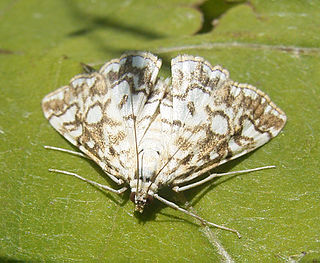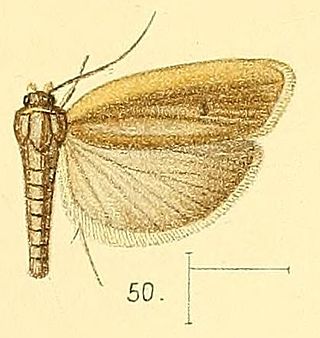
Spilomelinae is a very species-rich subfamily of the lepidopteran family Crambidae, the crambid snout moths. With 4,135 described species in 344 genera worldwide, it is the most speciose group among pyraloids.

The Pyralini are a tribe of snout moths described by Pierre André Latreille in 1809. They belong to the subfamily Pyralinae, which contains the "typical" snout moths of the Old World and some other regions. The genus list presented here is provisional.

The Republic of Baja California and Sonora or more simply known as the Republic of Sonora was a short-lived, unrecognized federal republic ruled by filibuster William Walker in 1854. It was based in Baja California and also claimed Sonora. Walker's actions generated interest back in San Francisco, where bonds for the Republic of Sonora were sold, and its flag was even raised in places. His enterprise, however, suffered from a lack of supplies and discontent from within; the Mexican government quickly forced Walker to retreat.

Hypena is a genus of moths in the family Erebidae. It was first described by Franz von Paula Schrank in 1802. These non-migratory moths overwinter as pupae and almost never estivate as adults.
Antona is a genus of moths in the subfamily Arctiinae. The genus was erected by Francis Walker in 1854.

Cosmosoma is a genus of tiger moths in the subfamily Arctiinae. The genus was erected by Jacob Hübner in 1823.

Ctenucha is a genus of moths in the family Erebidae.

Cyana is a genus of moths in the family Erebidae. Species are well distributed in Africa, Madagascar, China, India, Sri Lanka, Myanmar, Sumatra, Java and Borneo. The genus was erected by Francis Walker in 1854.

Cyanopepla is a genus of moths in the subfamily Arctiinae. The genus was erected by James Brackenridge Clemens in 1861.

Eressa is a genus of moths in the family Erebidae. The genus was erected by Francis Walker in 1854.

Leucotmemis is a genus of moths in the subfamily Arctiinae. The genus was erected by Arthur Gardiner Butler in 1876.

Lymire is a genus of tiger moths in the family Erebidae. The genus was erected by Francis Walker in 1854.

Virbia is a genus of tiger moths in the family Erebidae. The genus was erected by Francis Walker in 1854.

Herpetogramma is a genus of moths in the family Crambidae described by Julius Lederer in 1863. It currently comprises 106 species that are found in North America, Eurasia, Australia, New Zealand, Central and South America. Of the few species where host plants are known, the larvae mostly feed on grasses.

Pyrausta is a speciose genus of moths of the family Crambidae. The genus was erected by Franz von Paula Schrank in 1802.

Acentropinae is a fairly small subfamily of the lepidopteran family Crambidae, the crambid snout moths. Species of this subfamily are exclusively found in wetlands and aquatic habitats.

Odontiinae is a subfamily of moths of the family Crambidae. The subfamily was described by Achille Guenée in 1854.

Chrysocale principalis, the princely tiger moth, is a moth of the subfamily Arctiinae. It was described by Francis Walker in 1864. It is found in Mexico and Guatemala.

The Euchromiina are a subtribe of tiger moths in the family Erebidae. It was described by Arthur Gardiner Butler in 1876. Many species in the subtribe are mimics of wasps. Euchromiina have always been considered closely related to the subtribe Ctenuchina due to their similarity to moths and wasps. These two subtribes make up around 3,000 valid species, the majority of which occur in the Neotropics.

Stenoma is a genus of moths. The type species is Stenoma litura, which was described by Philipp Christoph Zeller in 1839.

























